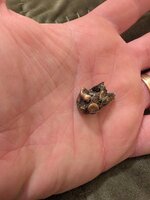- Joined
- May 1, 2024
- Messages
- 963
I have used this analogy before, but I’ll repeat myself here.
Heavy for caliber match bullets work differently than bullets of yesteryear because they are longer.
If you imagine two empty beer cans, one is standard size and the other is 18” tall, and step on them smash them, it takes longer to smash the 18” one.
The longer heavy for caliber match bullets may start to frag just as quickly as an old school soft point, but because of their length, there is much more bullet left by the time it has penetrated into the vitals and completes its fragmentation. Then of course the higher mass, means there is more material to frag and therefore increasing terminal effect.
Same thing applies comparing varmit bullets to heavy for cal match bullets.
Heavy for caliber match bullets work differently than bullets of yesteryear because they are longer.
If you imagine two empty beer cans, one is standard size and the other is 18” tall, and step on them smash them, it takes longer to smash the 18” one.
The longer heavy for caliber match bullets may start to frag just as quickly as an old school soft point, but because of their length, there is much more bullet left by the time it has penetrated into the vitals and completes its fragmentation. Then of course the higher mass, means there is more material to frag and therefore increasing terminal effect.
Same thing applies comparing varmit bullets to heavy for cal match bullets.



